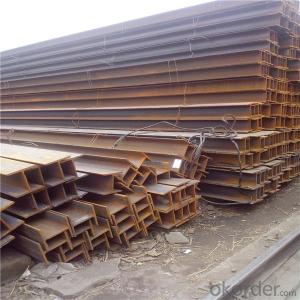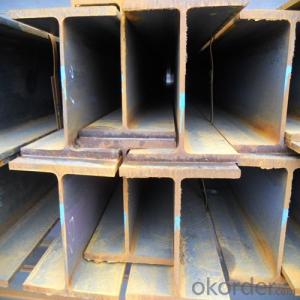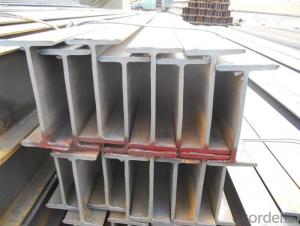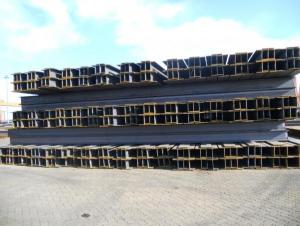China Hot Rolling Dip Galvanized H Beams Price per Kg
- Loading Port:
- Tianjin
- Payment Terms:
- TT OR LC
- Min Order Qty:
- 111 m.t
- Supply Capability:
- 10000 m.t/month
OKorder Service Pledge
OKorder Financial Service
You Might Also Like
Specification
Quick Details
OKorder is offering H BEAM at great prices with worldwide shipping. Our supplier is a world-class manufacturer of steel, with our products utilized the world over. OKorder annually supplies products to African, South American and Asian markets. We provide quotations within 24 hours of receiving an inquiry and guarantee competitive prices.
Place of Origin: | Tianjin, China (Mainland) | Grade: | Q235,Q345,Q215,Q195,20# | Technique: | Hot Rolled |
Thickness: | 3.2-6.5mm | Application: | Structural Beam | Length: | 6-12m, generally 12m, or according to your order |
Standard: | JIS, GB/T11263-2010/JISG3192-2008/EN10163 | Flange Width: | 58,59,123mm | Flange Thickness: | 4.5-6mm |
Web Width: | 118,119, 120mm | Web Thickness: | 4.5-6mm | Brand Name: | Yuxing |
Model Number: | HT 125x60/125x125 | product name: | Structural carbon steel h beam profile H iron beam (IPE,UPE,HEA,HEB) | Steel Grade(Equal International) 1: | SM490,SS400,S185,St33,S235JR,St37-2 |
Steel Grade(Equal International) 2: | ASTM A106/A106M A,S235JO, St37-3,E295, St50-2 | Steel Grade(Equal International) 3: | St50-2,S355JRH, ASTM A106/A106M C | Technical Method of Surface Treatment: | Hot-dipped galvanized |
Not of Specification: | The specification below in the table is more accurate | application: | structural beam | shape: | H beam |
We can provide qualify goods,competitive price and speedy delivery.
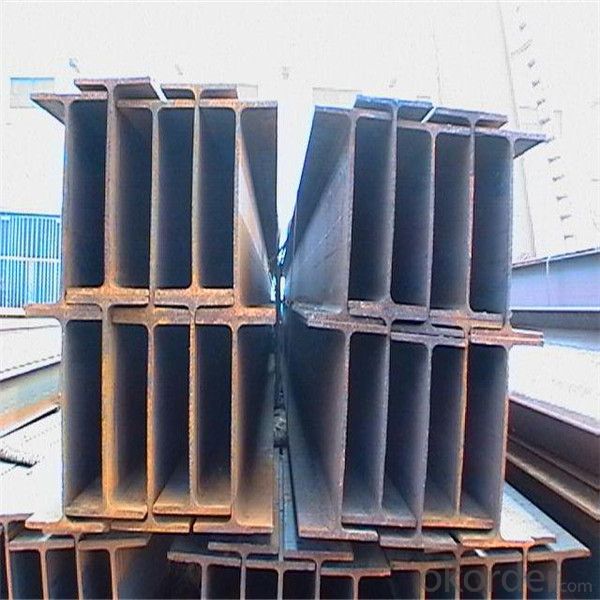
Products Description
H Type Steel Size and Theoretical Weight | |||||
Size | Theoretical Weight | Size | Theoretical Weight | Size | Theoretical Weight |
|
|
|
|
|
|
(mm) | (kg/m) | (mm) | (kg/m) | (mm) | (kg/m) |
100*50*5*7 | 9.3 | 250*125*6*9 | 29 | 446*199*8*12 | 65.1 |
100*100*6*8 | 16.9 | 250*250*9*14 | 71.8 | 450*200*9*14 | 74.9 |
125*60*6*8 | 13.1 | 294*200*8*12 | 55.8 | 482*300*11*15 | 110.8 |
125*125*6.5*9 | 23.6 | 298*149*5.5*8 | 32 | 488*300*11*18 | 124.9 |
148*100*6*9 | 31.1 | 340*250*9*14 | 36.7 | 496*199*9*14 | 77.9 |
150*75*5*7 | 14 | 300*150*6.5*9 | 93 | 500*200*10*16 | 88.1 |
150*150*7*10 | 20.7 | 300*300*10*15 | 78.1 | 582*300*12*17 | 132.8 |
175*90*5*8 | 18 | 346*174*6*9 | 41.2 | 588*300*12*20 | 147 |
175*175*7.5*11 | 40.4 | 350*175*7*11 | 49.4 | 596*199*10*15 | 92.4 |
194*150*6*9 | 29.9 | 350*350*12*19 | 134.9 | 600*200*11*17 | 103.4 |
198*99*4.5*7 | 17.8 | 390*300*10*16 | 104.6 | 700*300*13*24 | 181.8 |
200*100*5.5*8 | 20.9 | 396*199*7*11 | 56.1 | 800*300*14*26 | 206.8 |
200*200*8*12 | 49.9 | 400*200*8*13 | 65.4 | 900*300*16*28 | 240.1 |
244*175*7*11 | 43.6 | 400*400*13*21 | 171.7 |
|
|
248*124*5*8 | 25.1 | 440*300*11*18 | 120.8 |
|
|
Length=6------12meters | |||||
Packaging & Delivery
Packaging Details: | Packed with waterproof paper and steel banding. |
Delivery Detail: | 15-25 |
FAQ
1. How can I get some samples?
We are honored to offer you samples. New clients are expected to pay for the courier cost. The samples are free for you.
2 Do you have any certificates?
Our products passed inspection of SGS, FDA, and CE Quality is priority! Every worker keeps the QC from the very beginning to the very end, Quality control department especially responsible for quality checking in each process.
3 Can your factory print or emboss my logo on the goods?
Yes, we can print or emboss the logo on the goods or their packing box.
4 What information should I let you know if I want to get a quotation?
1) The specification of products (length x width x thickness);
2) The temper and alloy.
3) The final product you will use to be made
4 It will be better if you can show us the pictures or design sketch. Samples will be best for clarifying. If not, we will recommend relevant products with details for reference.We usually produce goods based on customers
Samples or based on customers’ picture, logo, sizes etc.
- Q: How do steel H-beams contribute to the overall sustainability of a transportation hub?
- Steel H-beams contribute to the overall sustainability of a transportation hub in several ways. Firstly, they are a durable and long-lasting structural element, ensuring the longevity of the infrastructure. This reduces the need for frequent repairs or replacements, thereby minimizing resource consumption and waste generation. Additionally, steel H-beams have a high strength-to-weight ratio, allowing for efficient and lightweight construction, which reduces the overall material and energy requirements during the construction process. Furthermore, steel is a highly recyclable material, making it easy to recover and reuse at the end of its service life, promoting a circular economy. Overall, the use of steel H-beams in a transportation hub enhances its sustainability by providing a robust, efficient, and environmentally friendly infrastructure solution.
- Q: How do steel H-beams contribute to energy-efficient building designs?
- The numerous benefits of steel H-beams make them crucial components in energy-efficient building designs. Firstly, their high strength-to-weight ratio allows them to support heavy loads while minimizing the steel required. This reduces the overall weight of the building's structure and foundation, resulting in energy savings during construction, transportation, and installation. Moreover, H-beams provide excellent structural integrity, ensuring the stability and durability of the building. They resist bending and twisting forces, allowing for the construction of larger spaces without excessive support columns or walls. The open web design of H-beams also facilitates the installation of insulation materials, enhancing thermal efficiency and reducing energy consumption for heating and cooling. Additionally, H-beams can be easily fabricated and customized to fit specific architectural designs. This enables architects to optimize the building's layout for natural lighting and ventilation. By incorporating large windows, skylights, and open spaces, energy-efficient buildings can maximize natural daylight and reduce the need for artificial lighting. Similarly, proper ventilation systems can be integrated, utilizing natural airflows to cool the building and decrease reliance on energy-intensive air conditioning. Furthermore, steel H-beams possess excellent fire resistance properties, critical for energy-efficient buildings. They withstand high temperatures and prevent fire spread, enhancing occupant safety and reducing the risk of structural damage. Consequently, the need for fireproofing measures, such as additional insulation or sprinkler systems, can be minimized, saving energy and resources in the long run. In conclusion, steel H-beams significantly contribute to energy-efficient building designs through their high strength-to-weight ratio, structural integrity, thermal efficiency, and versatility in design. Their fire resistance properties further enhance the safety and sustainability of these structures. By utilizing H-beams, architects and builders can create environmentally-friendly structures that promote energy conservation, reduce greenhouse gas emissions, and contribute to a more sustainable future.
- Q: How are steel H-beams classified based on their shape and size?
- Steel H-beams are classified based on their shape and size by considering factors such as the dimensions of the flanges and the web, as well as the weight per meter. This classification helps identify H-beams suitable for specific structural applications.
- Q: What are the considerations for designing with steel H-beams?
- When it comes to designing with steel H-beams, there are several important factors that must be kept in mind. Firstly, it is crucial to have a clear understanding of the load-bearing capacity of the H-beams. This involves determining the maximum weight that the beams can support and making sure that the design takes into account any potential dynamic or live loads that may be applied. The required strength of the beams can be calculated through structural analysis and design calculations, considering factors such as the span length, beam size, and material properties. Another factor to consider is the overall structural stability and rigidity of the H-beam design. While H-beams are known for their high strength-to-weight ratio, they can be vulnerable to lateral torsional buckling under certain conditions. Analyzing and designing for these potential stability issues is important to ensure the safety and integrity of the structure. This may involve adding additional bracing or stiffeners to the H-beams to enhance their stability. Proper connection detailing is also a crucial aspect of designing with steel H-beams. The connections between the H-beams and other structural members, such as columns or beams, need to be carefully designed to ensure that loads are transferred correctly and that there is structural continuity. The type of connection, whether it is bolted, welded, or a combination of both, should be chosen based on factors such as expected loads, construction constraints, and desired structural flexibility. Fire resistance is another consideration when working with steel H-beams. While steel is inherently fire-resistant, it can lose its strength and stiffness when exposed to high temperatures for extended periods. Therefore, it is important to think about fire protection measures, such as fireproof coatings or the use of fire-resistant materials, to ensure that the H-beams maintain their structural integrity in the event of a fire. Lastly, the cost and availability of steel H-beams should be taken into account during the design process. The size, grade, and quantity of H-beams needed for the project can impact the overall cost and feasibility of the design. It is also important to consider the availability of the required H-beams in the market to avoid potential delays or cost overruns. In conclusion, designing with steel H-beams requires careful consideration of load-bearing capacity, structural stability, connection detailing, fire resistance, and cost factors. By addressing these factors, a well-designed H-beam structure can be achieved that meets the necessary performance criteria and ensures the safety and durability of the project.
- Q: What does "welding H" steel set "vertical" and "corrective processing" mean?
- The steel plant produces H steel with a special machine to process a 500*300*12*10 H steel of a length of 12 meters
- Q: Can steel H-beams be used in architectural applications?
- Steel H-beams are indeed suitable for architectural applications. They are extensively utilized in construction and engineering endeavors owing to their robustness, longevity, and adaptability. When employed in architectural contexts, H-beams are capable of forming the foundational frameworks of buildings, bridges, and other structures. By supplying support and stability, they enable the creation of more expansive open spaces and offer flexible design choices. Moreover, H-beams can be employed for aesthetic purposes, imparting an industrial or contemporary appearance to architectural designs. By taking into account meticulous engineering and design considerations, it is entirely viable to integrate steel H-beams into diverse architectural applications with success.
- Q: Can steel H-beams be used for water treatment plants?
- Steel H-beams are indeed suitable for use in water treatment plants. They are a flexible and widely utilized structural element in different construction undertakings, including water treatment facilities. Their exceptional strength and resilience make them ideal for bearing heavy loads and enduring harsh environmental circumstances. In the realm of water treatment plants, steel H-beams can serve multiple purposes, such as forming the facility's framework, providing support for machinery and equipment, and establishing walkways and platforms. Moreover, steel H-beams can be effortlessly fabricated and tailored to meet precise design specifications, guaranteeing a perfect fit and optimal performance in the construction of water treatment plants.
- Q: What are the different applications of steel H-beams?
- Steel H-beams have various applications across industries such as construction, engineering, and manufacturing. They are commonly used as structural supports in buildings, bridges, and other infrastructure projects, providing strength and stability. H-beams are also utilized in the manufacturing of heavy machinery, cranes, and equipment frames, as they can withstand heavy loads and distribute weight efficiently. Additionally, H-beams find applications in the automotive industry for the construction of chassis, and in the aerospace industry for the fabrication of aircraft structures. Overall, the versatility and durability of steel H-beams make them essential components in a wide range of applications.
- Q: Can steel H-beams be used in retail or shopping mall construction?
- Yes, steel H-beams can be used in retail or shopping mall construction. Steel H-beams are commonly used in construction projects due to their strength, versatility, and cost-effectiveness. They provide structural support and can bear heavy loads, making them suitable for large-scale commercial buildings like retail or shopping malls.
- Q: What are the different types of connections used for steel H-beams to masonry?
- There are several types of connections commonly used for steel H-beams to masonry. These connections are designed to ensure a secure and stable bond between the steel beam and the masonry structure. One common type of connection is the welded connection. In this method, the steel beam is welded directly to the masonry using high-strength welding techniques. Welded connections provide excellent strength and rigidity, making them a popular choice for heavy-duty applications. Another type of connection is the bolted connection. This involves using bolts and nuts to secure the steel beam to the masonry. Bolted connections allow for easy disassembly and reassembly, making them suitable for situations where the steel beam may need to be removed or replaced in the future. An alternative to traditional welding or bolting is the use of mechanical connectors. These connectors, also known as steel plates or brackets, are designed to provide a strong connection between the steel beam and the masonry. They are typically attached to the beam using bolts or welds and then embedded in the masonry during construction. Additionally, adhesive connections can be used to bond the steel beam to the masonry. This involves using a high-strength adhesive material that is applied between the beam and the masonry surface. Adhesive connections provide a clean and aesthetically pleasing appearance since they are hidden from view. The choice of connection type depends on various factors such as the load-bearing requirements, structural design, construction method, and project specifications. It is essential to consult with a structural engineer or a professional with expertise in steel-to-masonry connections to determine the most suitable connection method for a specific project.
Send your message to us
China Hot Rolling Dip Galvanized H Beams Price per Kg
- Loading Port:
- Tianjin
- Payment Terms:
- TT OR LC
- Min Order Qty:
- 111 m.t
- Supply Capability:
- 10000 m.t/month
OKorder Service Pledge
OKorder Financial Service
Similar products
Hot products
Hot Searches
Related keywords
